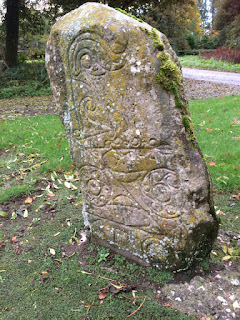Aberlemno Stone

Battle of Dunnichen This piece is a follow-up to King Bidei The Picts have left a unique record of the battle in the form of a magnificent piece of sculpture. The so-called Battle Stone in Aberlemno kirkyard - about four miles north of Dunnichen-is a Pictish stone, 2.3 metres high. It has a cross in heavy relief on one side and Pictish symbols on the other, above a vivid portrayal of warriors in battle. There are several good reasons for thinking that the scenes on the Aberlemno Stone depict the Battle of Dunnichen. Experts date it to the early 8th century, within a few decades of the event. It is not far from the site of the battle. And one set of warriors on the stone is wearing helmets with long nose-guards of a type known to have existed among the Anglo-Saxons. It is a remarkable record of the battle, showing superb details of weapons and methods of fighting – the Pictish equivalent of the Bayeux Tapestry. The Aberlemno Battle Stone has four separate images from th...


